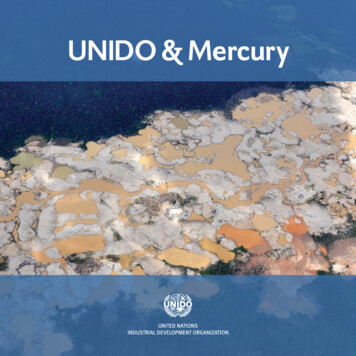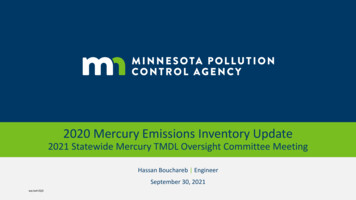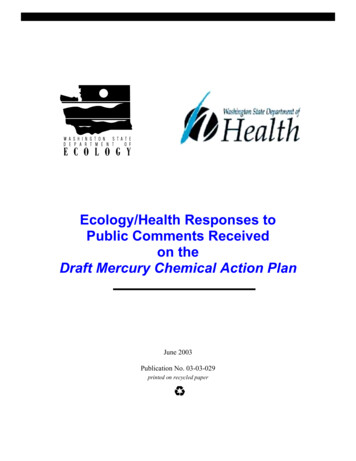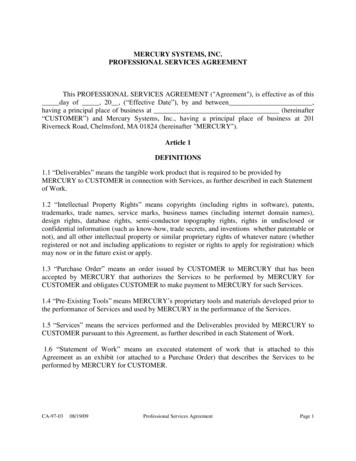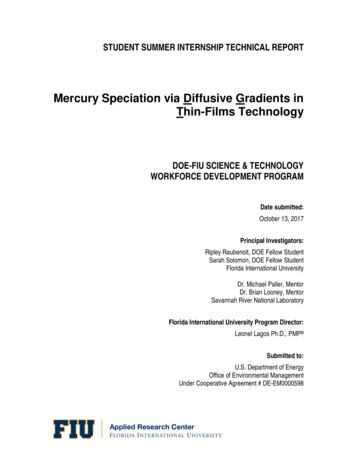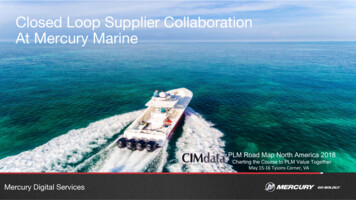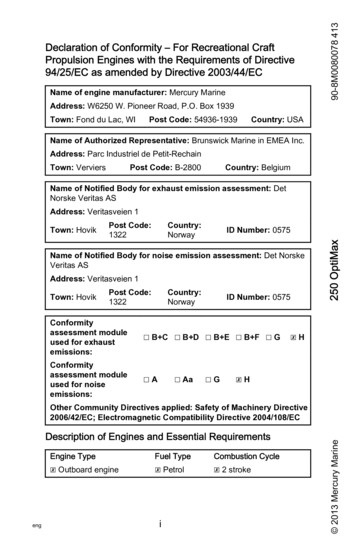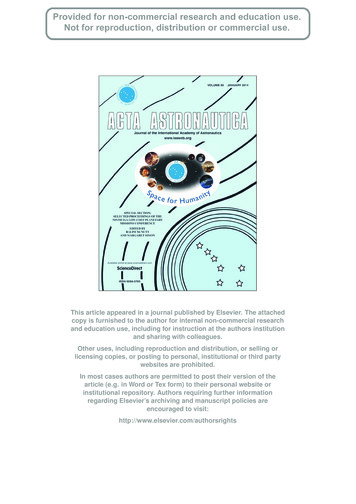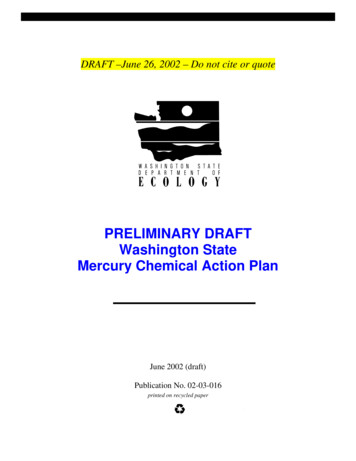
Transcription
DRAFT –June 26, 2002 – Do not cite or quotePRELIMINARY DRAFTWashington StateMercury Chemical Action PlanJune 2002 (draft)Publication No. 02-03-016printed on recycled paper
This document is available on the Department of Ecology home page on theWorld Wide Web at http://www.ecy.wa.gov/biblio/0203016.htmlComments on this draft plan can be e-mailed to Cheri Peele atchep461@ecy.wa.govThe Department of Ecology is an equal opportunity agency and does notdiscriminate on the basis of race, creed, color, disability, age, religion, nationalorigin, sex, marital status, disabled veteran's status, Vietnam era veteran's status,or sexual orientation.If you have special accommodation needs or require this document in alternativeformat, please contact Joan LeTourneau, Environmental Assessment Program, at(360)-407-6764 (voice). Ecology's telecommunications device for the deaf (TDD)number at Ecology Headquarters is (360) 407-6006.
PRELIMINARY DRAFTWashington StateMercury Chemical Action PlanbyCheri PeeleEnvironmental Assessment ProgramOlympia, Washington 98504-7710June 2002 (draft)Publication No. 02-03-016printed on recycled paper
This page is purposely left blank for duplex copying
Table of ContentsPagePurpose of this Document . ivMercury Chemical Action Plan Committee . vGoals and Purpose. 1Preliminary Screening Process. 2Potential Strategic Directions for Near-Term Action . 3Mercury products- General . 3Mercury Products- Specific Products and Sectors . 3General Education Campaign/ Thermometer Exchanges . 3Fluorescent Lamps . 3Thermostats. 4Dental Facilities . 4Medical Facilities. 4Auto Switches . 5K – 12 Schools. 5Mining . 6Lode Gold Mining . 6Abandoned Mine Cleanup . 6Human Use and Release of Mercury. 71. Mercury Release from Fossil Fuel Combustion. 7Coal-Fired Power Plants. 7Fuel Oil: Distillate, Residual and Crude . 9Oil Refineries . 12Wood Stoves . 132. Mining and Manufacturing . 16Mining . 16Mercury Mining. 16Gold Mining. 17Manufacturing . 20Manufacturing of Mercury-Added Products . 23Instrument Manufacturers. 23Manufacturing of Products where Mercury is a Contaminant . 24Pulp and Paper . 24Industrial Inorganic Chemicals. 25Cement Manufacturing . 26Lime Manufacturing . 26Secondary Steel Smelters. 27Primary Production of Aluminum . 273. Use of Products Containing Mercury . 28Specific Products and User Groups. 30Medical Facilities. 30Dental Facilities . 33Veterinarians . 36Batteries . 36DRAFT – Do not cite or quote - Page i
HVAC systems . 37Fluorescent Lamps . 39K – 12 Schools. 42Universities . 44Laboratories. 45Mercury Products in Cars . 45State Purchasing. 50Dairies . 524. Products Containing Mercury at End-of-Life . 54Disposal of Products Containing Mercury. 54Municipal Waste Combustors. 54Medical Waste Incinerators . 55Landfills . 57Medical Waste Autoclaves and Retorts . 58Publicly Operated Treatment Works (POTW’s) . 60Septic Systems . 63Sewage Sludge Incinerators. 64Auto Recyclers. 65Steel Recyclers. 65Crematoria . 66Recycling and Disposal as Hazardous Waste of Products Containing Mercury. 68Household Hazardous Products Facilities . 68Lamp Recyclers . 69Hazardous Waste Contractors. 69Mercury Retirement . 69Mercury in the Environment . 71Air. 71Water . 71Sediment. 72Toxic Waste Cleanup Sites . 74Mercury in the Food Chain . 77Fish . 77Fish-eating Birds . 77Fish-eating Mammals. 77Humans. 78Research and Monitoring . 79Ongoing Research . 79Washington State Toxics Monitoring Program . 79Monitoring Program to Verify 303(d) Metals Listings for Selected Rivers and Creeks. 79Puget Sound Ambient Monitoring Program . 79Statewide Mercury in Fish Tissue Project . 80Lake Whatcom Mercury in Sediment Project. 80Quicksilver Caucus – EPA Mercury Stewardship Initiative . 80EPA Region 10 Mining Workgroup . 81Mercury Deposition Network . 81Planned Research . 81Page ii - DRAFT – Do not cite or quote
Survey of Mercury Research Activities in Washington State . 81Literature Review: Impact of fish consumption advisories on consumerbehavior . 82Potential Research Questions . 82Bibliography of Existing Washington State Research . 82Duwamish Waterway. 82Fish Consumption . 82Lake Roosevelt – Columbia River. 83Lake Whatcom . 83Monitoring - General . 84Sinclair and Dyes Inlets . 84Spokane River. 84Preliminary Mercury Release Inventory . 85AppendicesA:B:C:D:E:F:Regulatory OverviewSummary of Department of Ecology Data SourcesDepartment of Health Fish Advisory Talking PointsDepartment of Health Fish Advisories Frequently Asked Questions and Answers.2000 Toxics Release Inventory Data for MercuryOccurrences of Cinnabar in Washington StateDRAFT – Do not cite or quote - Page iii
Purpose of this DocumentThe purpose of this document is to identify sources of mercury, outline the existing regulatorystructure around mercury and existing mercury reduction efforts, and identify possible strategiesfor further mercury reduction. Using this information, the Departments of Ecology and Healthhave made initial prioritizations of mercury sources for reduction and elimination, potentialstrategies for accomplishing this, and have identified areas for further research.This is a working document; not all of the information contained has been confirmed. TheDepartments expect that it will be modified over the coming months as a result of furtherresearch by Department staff, comments from the Mercury Advisory Committee, and commentsreceived during the public comment period.Page iv - DRAFT – Do not cite or quote
Mercury Chemical Action Plan CommitteeDepartment of EcologyCheri PeeleMike GallagherMercury Policy CoordinatorPersistent Bioaccumulative Toxin Strategy CoordinatorEnvironmental Assessment ProgramJon BennetLydia LindwallCheryl NiemiMaria PeelerTom ToddSolid Waste and Financial Assistance ProgramToxics Cleanup ProgramWater Quality ProgramHazardous Waste and Toxics Reduction ProgramAir Quality ProgramDepartment of HealthDr. Harriet AmmannJoanne Bonnar PradoOffice of Environmental Health AssessmentsOffice of Environmental Health AssessmentsDRAFT – Do not cite or quote - Page v
Goals and PurposeThe Mercury Action Plan is designed to meet two, co-equal goals:1. Virtually elimination of the use and release of anthropogenic mercury in WashingtonState.2. Minimize human exposure to anthropogenic mercury.“Virtual elimination” is defined for this document as a reduction of mercury releases to the air,water and land from anthropogenic, or man-made, sources using life-cycle management practices(e.g., pollution prevention and release controls) so as to approach the levels and fluxes ofmercury that would be expected from naturally-occurring processes. This virtual eliminationgoal is identical to that expressed in the US EPA Working Draft: PBT National Action Plan forMercury, the Canada-US Binational Toxics Strategy for the Great Lakes and in the tri-lateralNorth American Regional Action Plan developed by Canada, the US and Mexico.to be completed: Short-term ObjectivesDRAFT – Do not cite or quote - Page 1
Preliminary Screening ProcessThe Mercury Chemical Action Plan Committee, made up of Department of Ecology andDepartment of Health staff, has reviewed the known anthropogenic sources of mercury inWashington State and potential reduction and elimination strategies. As part of a preliminaryscreening process, sources were evaluated by size and potential strategies were passed through aseries of yes/no “screens”: Does the strategy make use of an existing reduction option or regulation?Does the strategy focus on pollution prevention?Would the strategy result in a cross-media transfer that reduces or eliminates exposure?Would the strategy increase public education about mercury?Is the strategy technically feasible?Has the strategy worked in other locations? Is it consistent with the US EPA Working Draftof the PBT National Action Plan for Mercury?In each case, the preferred answer was “yes.” Based on this review, a short list of sources andpotential strategies for near-term action was developed. This list is still undergoing internalreview through the summer of 2002, including cost analysis.Since the initial screening, additional sources and possible strategies have been identified. Theseare included in the draft, but are still in the process of being evaluated.Page 2 - DRAFT – Do not cite or quote
Potential Strategic Directions forNear-Term Action(All strategies listed subject to further evaluation.)Mercury products- Generalestimated annual release in Washington: 1,800 poundspossible strategies: Support development and passage of legislation to require labeling, manufacturer collectionand phase-out of mercury productsreasons: Products are the largest source of mercury in Washington State. Nearly all mercury-added products have readily available cost-effective alternatives. Focus on pollution prevention. Product legislation of varying degrees has been passed in 10 other states.Mercury Products- Specific Products and SectorsGeneral Education Campaign/ Thermometer Exchangesestimated annual release in Washington: 12 poundsestimated total amount of mercury that could be collected: 1,152 poundspossible strategies: Grants to counties to conduct thermometer exchanges (ongoing) Joint thermometer exchange and education campaign with Washington State PharmacyAssociationreasons: Public education is necessary to reduce releases of mercury from consumer products. Thermometer exchanges have been extremely successful public education tools in otherstates. The volume of mercury that can potentially be collected through a statewide thermometerexchange is very large.Fluorescent Lampsestimated annual release in Washington: 507 poundspossible strategies: Increase grant funding to counties for fluorescent collection Application of Universal Waste RuleDRAFT – Do not cite or quote - Page 3
Outreach and education to building managers on Universal Waste Rulereasons: Large single source of mercury. Regulatory structure and collection infrastructure to prevent releases already in place.Thermostatsestimated annual release in Washington: 430 poundspossible strategies: Support expansion of Thermostat Recycling Corporation Work with Building Code Council to change state building code to prohibit use of newmercury gauges and switches Require that HVAC systems be checked for mercury gauges and switches before demolition Outreach and education to contractorsreasons: Relatively large single source of mercury Partial collection infrastructure (wholesalers) could be put into place at no cost to consumer Focus on pollution prevention- precedent for ban on installation of mercury thermostatsexists in Oregon and Rhode Island.Dental Facilitiesestimated annual release in Washington: 400 poundspossible strategies: Require use of amalgam separators and best management practices by dentists Outreach and education for dental staff Approach the Insurance Commissioner on equal coverage for amalgam and non-mercuryrestorativesreasons: Relatively large single source of mercury Amalgam separators are available that will remove 95 percent of mercury particles in dentaleffluent Fifty percent of Washington dentists, those who practice in King County, are required tofollow best management practices and will be required to install amalgam separators by June2003. Insurance Commissioner- focus on pollution preventionMedical Facilitiesestimated annual release in Washington: Unknown. In other areas of the country, however,medical facilities have consistently been one of the largest sources of mercury to POTW’s. ThePage 4 - DRAFT – Do not cite or quote
Washington State Hospital Association is currently conducting a survey to determine the use ofmercury products in hospitals.possible strategies: Voluntary mercury reduction program by medical facilities Mandatory mercury reduction by medical facilities Outreach and education for medical staffreasons: Potentially large point source of mercury Strategies focusing on purchasing practices, disposal methods, and general outreach andeducation to medical staff have been very effective in other areas of the countryAuto Switchesestimated annual release in Washington: 253 poundspossible strategies: Replace switches at state inspections Place bounty on switches funded by car manufacturers Require auto dismantlers to make reasonable effort to remove switches Support legislation to ban use of mercury in vehicles Voluntary exchange programs and incentivesreasons: Relatively large single source of mercury Currently, large percent of mercury from auto switches is released to the air at secondarysteel smelters, which are not regulated for mercury emissions A number of states are focusing on this issue in a coordinated fashionK – 12 Schoolsestimated annual release in Washington: Unknown.possible strategies: Finish Rehab the Lab project Work with Healthy Schools Task Forcereasons: Children are particularly vulnerable to the effects of mercury, including breathing mercuryvapors released following a spill. Mercury spills have proven extremely costly for schools in other parts of the country. The Rehab the Lab project has already removed mercury, among other unnecessarychemicals, from approximately 50 percent of middle and high schools in the state. The Healthy Schools Task Force is an ongoing, multi-agency effort, which has expressedinterest in removing mercury from K – 12 schools.DRAFT – Do not cite or quote - Page 5
MiningLode Gold Miningestimated annual release in Washington: 777 poundspossible strategies: Work with EPA and gold mines to improve characterization of mercury emissions. Work with EPA and gold mines to improve characterization of control technologies. Work with EPA and gold mines to investigate voluntary reduction initiatives.reasons: Very large single source of mercury in Washington State. Little is currently known about the fate and potential reduction opportunities for mercuryemissions. Consistent with EPA PBT National Action Plan for Mercury (Working Draft)Abandoned Mine Cleanupestimated annual release in Washington: Unknownpossible strategies: Work with federal government agencies and the Washington Department of NaturalResources to focus specifically on potential mercury releases in their assessments ofabandoned mines for clean up.reasons: Runoff from abandoned placer gold mines has been identified as one of the sources ofmercury to Lake Roosevelt. Estimates are there may be as many as 3500 abandoned metals mines in the 68 miningdistricts in Washington. Of these, it is estimated that approximately 500-600 are consideredsignificant (more than 200 pounds of product produced during the life of the mine). Assessment and clean up of abandoned mines is ongoing, but presently there is no focus onmercury as a criterion for clean up.Page 6 - DRAFT – Do not cite or quote
Human Use and Release of Mercury1. Mercury Release from Fossil Fuel CombustionCoal-Fired Power PlantsIdentification and Description of SourceNationally, coal-fired power plants are the largest known source of anthropogenic mercuryemissions. Washington has fewer coal fired power plants than the Midwest and the Easternregions of the country, although the state has other sources that burn coal.Washington State has only one coal-fired utility, Transalta Centralia Steam Plant. The powerplant has two separate generating units that were constructed in 1971 and 1972. The totalproduction capacity of the two units is 1,300,000 kilowatts, enough power to supply a city thesize of Seattle. In the generation of the electricity the plant consumes approximately 5 milliontons of coal per year.As a part of its current air emissions control measures, which meet existing national standards,the Centralia Power Plant uses large electrostatic precipitators (ESP) to remove fly ash from itsendpoint emissions. The ESP is credited with a high degree of efficiency.Quantity and Estimated UncertaintyAccording to the Toxics Release Inventory, the Transalta Centralia steam plant released 436pounds of mercury in 2000. Of the mercury released, 374 pounds was reported emitted to air,0.29 pounds to water, and 62 pounds to land. The air emissions were based on a combination ofstack tests and sampling of the coal.Centralia Power Plant has reported mercury emissions for 10 years to Southwest Clean AirAgency. Emissions have been estimated from a stack test in 1992 and from coal mercury testing.In 1999, the EPA required extensive coal mercury testing for coal-fired power plants. The coalburned by the Centralia Power Plant has a mercury content of about 60 parts per billion;primarily elemental mercury which is not collected well by control equipment for otheremissions. The coal mined at Centralia is washed before combustion, which will remove somemercury. The power plant has two electrostatic precipitators to remove coal ash particulate;some mercury is also removed with the ash in the precipitators.Sectors AffectedTransalta Centralia steam plant, Southwest Regional Air Authority, Yakama Tribe, others whoconsume fish downwind of the facilityDRAFT – Do not cite or quote - Page 7
Current Regulations and PolicyMercury emissions from coal-fired power plants are not currently limited by law or regulation.The US Department of Energy has set goals to reduce mercury emissions from coal plants by 50to 70 percent by 2005 and 90 percent by 2010.Recent ActivitiesIn 1997, the Southwest Clean Air Agency (SWCAA) completed a Reasonably Available ControlTechnology (RACT) review of the Centralia Power Plant. Although the focus of the RACTreview was on sulfur dioxide and nitrogen oxides, the evaluation included mercury and otherhazardous air pollutants. The 1996 emissions of 390 pounds/year were modeled and theresulting ambient air impact was 0.3 % of the Acceptable Source Impact Level (ASIL). TheRACT Review acknowledged that the proposed emissions controls should also remove somemercury, however, mercury was not identified as a pollutant of concern for RACT review.As a result of the review, SWCAA ordered new emission controls installed under authority ofRCW 70.94.154. The first of two scrubbers, or Flue Gas De-Sulfurization Units, started up inOctober 2001; the 200 million project will be complete in July 2002. Although they aredesigned primarily to remove sulfur dioxide from the flue gas, they will also remove mercurydue to cooling of the exiting gas temperature. The removed mercury will end up in wall boardthat will be manufactured from the waste products of this process.In March 2002, TransAlta tested the mercury emissions of the scrubbed unit. Initial results showthe mercury removal is about one-third.Ongoing ActivitiesThe Bush Administration, Senator Jeffords of Vermont and others have proposals to reducemercury pollution from coal fired power plants. It remains to be seen what will emerge fromCongress. The final law will probably not be passed until sometime in 2003.In December 2000, under the Clinton Administration, EPA announced it had affirmativelydecided that mercury air emissions from power plants should be regulated under the Clean AirAct, because mercury poses great hazards to public health. Under this decision, EPA is topropose regulations by 2003 and issue final rules by 2004.2Currently, several multi-pollutant bills are being considered in Congress that would either setmercury emissions limits for coal-fired power plants or, as the Bush Administration is proposing,establish a cap and trade , 3/4/02.Page 8 - DRAFT – Do not cite or quote
The US Department of Energy is funding six research projects to develop innovativetechnologies to reduce mercury emissions from coal plants at a lower cost than currenttechnologies.3Reduction OptionsDevelop state regulations requiring reduced emissions.ScreenStrategy uses an existing reduction option or regulationFocus on pollution preventionResult in cross-media transfer that reduces or eliminates exposureIncrease public educationTechnically feasibleStrategy has worked in other locations/ consistent with EPAResponseNoNoYesNoUnknownNoFuel Oil: Distillate, Residual and CrudeIdentification and Description of SourceDistillate fuels include jet fuels, diesel fuels, heating oil, and kerosene. Residual oil is composedof the heaviest components of crude oil. It can be thought of as that portion of the crude oil thatis left over when all other products are removed, hence the name “residual.” Most residual oil isburned to generate electricity or to provide power to relatively large industrial processes. It isalso the prime fuel source for ocean-going ships.4Mercury is thought to exist as a contaminant in all fuel oils. It is assumed that all mercurypresent in fuel oils will be released into the atmosphere during the combustion process.Quantity and Estimated UncertaintyConcentrations of mercury in fuel oil depend upon the type of oil used. No comprehensive oilcharacterization studies have been done, but data in the literature report mercury concentrationsin crude oil ranging from 0.023 to 30 parts per million by weight, while the range ofconcentrations in residual oil is 0.007 to 0.17 parts per million by weight. Because EPA foundonly a single mean value in the literature f
The Mercury Action Plan is designed to meet two, co-equal goals: 1. Virtually elimination of the use and release of anthropogenic mercury in Washington State. 2. Minimize human exposure to anthropogenic mercury. "Virtual elimination" is defined for this document as a reduction of mercury releases to the air,
